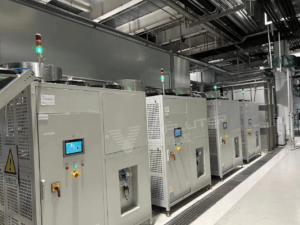In the fields of industrial wastewater treatment, high-salt waste liquid concentration, biopharmaceutical purification, etc., low-temperature evaporation technology has gradually become the mainstream choice of the industry due to its high efficiency, energy saving and environmentally friendly characteristics. This article will give you a comprehensive understanding of the current mainstream low-temperature evaporation process from the perspectives of technical principles, core processes, and applicable scenarios.
Why is the low-temperature evaporation process “high efficiency and energy saving”?
Low-temperature evaporation process is an efficient and energy-saving evaporation method. According to the temperature-pressure formula, when the volume of the liquid remains unchanged, the lower the pressure, the lower the boiling point of the liquid. The low-temperature evaporation process is based on this principle. By reducing the internal pressure of the evaporator, increasing the vacuum degree, and reducing the boiling point of the liquid, the evaporation rate of the liquid is increased. For example, in a vacuum environment, the boiling point of water can be as low as 30°C, and the evaporation process only requires a small amount of heat energy to start. At the same time, combined with heat pump technology, as a heat source recycling, energy consumption is reduced by more than 50% compared with traditional evaporation technology.
Classification and characteristics of low-temperature evaporation process
1. Heat pump type low-temperature evaporation process
Principle: Use the heat pump compressor to compress the refrigerant and heat it up, release heat to heat the wastewater; the refrigerant expands and absorbs heat to refrigerate, and condenses the steam into water.
Advantages: Low-temperature evaporation, operating temperature 35-40℃, heat-sensitive substances are not easy to decompose; no external steam is required, all-electric drive, high degree of automation.
Applicable scenarios: low-temperature evaporation and concentration of aqueous solutions such as Chinese medicine concentration, plant extraction, biological fermentation, food processing, etc.; concentration and reduction of high-concentration heavy metal wastewater in surface treatment/electroplating fields, machining cutting fluid wastewater, and high-concentration wastewater in the semiconductor industry.
2. Steam type low-temperature evaporation process
Principle: Through the characteristics of steam circulation and scraper structure, the spiral stirring scraper system is used under vacuum negative pressure (about -95kPa) to specially treat high-salinity, high-boiling-point, and high-viscosity wastewater, realizing energy-saving technology for wastewater evaporation, concentration, crystallization, and drying.
Advantages: Low-temperature evaporation, operating temperature 35-40℃, deep crystallization of high-concentration wastewater.
Applicable scenarios: Fine chemicals – evaporation reduction of evaporation crystallization mother liquor in the fields of pesticides, pharmaceuticals, and new materials; crystallization and drying of impure salt mother liquor in zero-emission fields such as coal chemical industry, petrochemical industry, oil and gas field mining, non-ferrous smelting, etc.

Applicable scenarios of low-temperature evaporation process
1. Pharmaceutical and food industries, low-concentration and heat-sensitive liquid materials
The low-temperature evaporator can efficiently achieve concentration treatment under low temperature environment, and retain the activity and quality of the effective ingredients in the material to the greatest extent.
2. Chemical industry, high-concentration and high-difficulty solutions as intermediate raw materials and wastewater generated in the production process
The low-temperature evaporator, with its unique low-temperature evaporation technology advantages, not only effectively separates the water in it, realizes the concentration and reuse of materials or the reduction of wastewater treatment, but also greatly reduces energy consumption.
3. Mechanical processing, surface treatment industry, oil-containing product wastewater and electroplating wastewater
The low-temperature evaporator can efficiently cope with the concentration treatment needs of such complex wastewater and effectively solve the problem of wastewater treatment.
Four core advantages of low-temperature evaporation process
Energy saving and consumption reduction: Heat pump technology can recycle more than 80% of heat energy, and the energy consumption per ton of water treatment is as low as 30-50kW·h.
Environmental protection and safety: Low-temperature operation reduces coking and harmful gas emissions, and condensed water can be reused up to the standard.
Strong adaptability: It can handle complex water quality such as high salt, high COD, and oily wastewater.
High degree of automation: Integrated PLC control to achieve automatic feeding, defoaming, and slag discharge, reducing manual intervention.

Practical application cases
Case 1: Concentration of Chinese medicine extracts in a well-known pharmaceutical company
The customer uses low-temperature evaporation concentration technology, with a daily processing capacity of 30 tons of Chinese medicine extracts, which can concentrate the crude product to the specified concentration ratio, not only improving the production capacity of Chinese medicine, but also improving the safety of equipment operation and reducing operating energy consumption.
Case 2: Crystallization of impure salt mother liquor in a well-known coal chemical enterprise
The customer uses low-temperature evaporation technology, with a daily processing capacity of 15 tons of terminal impure salt mother liquor, which can effectively inhibit the formation of scale, reduce the difficulty of system cleaning and maintenance, and improve the utilization efficiency of equipment.
Case 3: Concentration and crystallization of zinc-nickel alloy wastewater in a surface treatment industrial park
The customer uses low-temperature evaporation technology to treat 20 tons of zinc-nickel alloy wastewater per day. The nickel content of distilled water is<0.1ppm, and the moisture content of the concentrate is ≤18%, which shortens the overall treatment process and ensures the terminal drainage indicators.

Low-temperature evaporation technology is reshaping the industrial waste liquid treatment landscape with its advantages of “energy saving, high efficiency, and greenness”. When choosing, enterprises need to combine water quality characteristics, treatment scale, and cost budget to match the best process solution. With technological advances, low-temperature evaporation will become one of the key environmental protection technologies to achieve the “dual carbon” goal.
